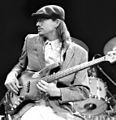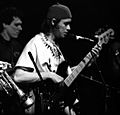Jaco Pastorius facts for kids
Quick facts for kids
Jaco Pastorius
|
|
|---|---|
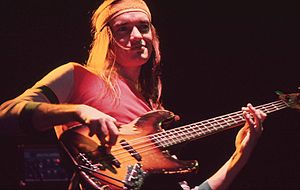
Pastorius in 1980
|
|
| Background information | |
| Birth name | John Francis Anthony Pastorius III |
| Born | December 1, 1951 Norristown, Pennsylvania, U.S. |
| Died | September 21, 1987 (aged 35) Fort Lauderdale, Florida, U.S. |
| Genres |
|
| Occupation(s) |
|
| Instruments |
|
| Years active | 1966–1987 |
| Labels | |
| Associated acts |
|
John Francis Anthony "Jaco" Pastorius III (born December 1, 1951 – died September 21, 1987) was an American jazz bassist, composer, and music producer. He made many albums as a solo artist and also led his own band. Jaco was also a key member of the jazz fusion group Weather Report from 1976 to 1981. He worked with many other famous artists, especially Pat Metheny and Joni Mitchell.
Jaco's bass playing style often used funk music elements. He was known for his beautiful solos, playing chords on the bass, and using harmonics in new ways. By 2017, he was the only electric bass player in the DownBeat Jazz Hall of Fame. Many people consider him one of the greatest bassists of all time.
Sadly, Jaco Pastorius faced personal challenges later in his life. Despite his musical fame, he found it hard to keep jobs because he was sometimes unreliable. He often had money problems and was even homeless in the mid-1980s. He passed away in 1987 after an incident outside a club in South Florida.
Since his death, Jaco's music has continued to inspire many musicians. He was added to the DownBeat Hall of Fame in 1988. A documentary film about his life, called Jaco, was released in 2014.
Contents
Who Was Jaco Pastorius?
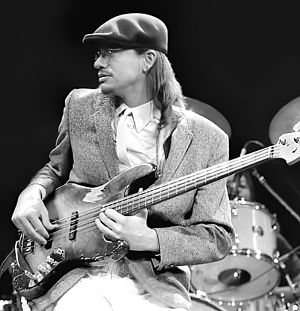
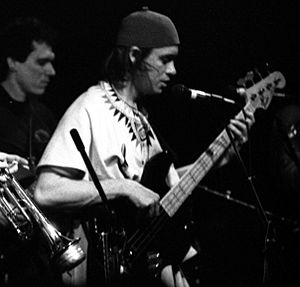
Jaco's Early Life and Family
John Francis Pastorius was born on December 1, 1951, in Norristown, Pennsylvania, USA. He was the oldest of three boys. His mother, Stephanie, was from Finland. His father, Jack Pastorius, was a singer and jazz drummer who traveled a lot for his music. When Jaco was eight, his family moved to Oakland Park, near Fort Lauderdale, Florida. A very early American activist for freedom, Francis Daniel Pastorius, was one of his ancestors.
Jaco's nickname, "Jaco," came from his love for sports and the umpire Jocko Conlan. In 1974, he started spelling it "Jaco" after his neighbor, pianist Alex Darqui, spelled it that way by mistake. His brother used to call him "Mowgli" (from The Jungle Book). This was because Jaco was very energetic and often spent time shirtless on the beach, climbing trees, running in the woods, and swimming. He went to St. Clement's Catholic School and was an altar boy. His confirmation name was Anthony, which made his full name John Francis Anthony Pastorius. He loved competition and was very good at baseball, basketball, and football.
Jaco played the drums until he hurt his wrist playing football at age thirteen. The injury was serious and needed surgery. It made it hard for him to play the drums anymore.
Jaco's Musical Journey and Education
Around 1968–1969, when he was 17, Jaco started to love jazz music. He saved enough money to buy an upright bass. He liked its deep, soft sound, but it was expensive to keep. He found it hard to maintain the instrument because of the humidity in Florida. One day, he woke up to find it had cracked. So, he traded it for a 1962 Fender Jazz Bass.
As a teenager, he played bass guitar for a band called Wayne Cochran and the C.C. Riders.
In the early 1970s, Jaco taught bass at the University of Miami. There, he became good friends with jazz guitarist Pat Metheny, who also taught there. Jaco and Pat Metheny recorded an album together in 1974. Jaco then played on Pat Metheny's first album, Bright Size Life, in 1976. Jaco released his own first solo album, Jaco Pastorius, in 1976. Many famous musicians played on this album, including Herbie Hancock and Wayne Shorter.
Joining Weather Report
Before making his first album, Jaco went to a concert in Miami by the jazz fusion band Weather Report. After the show, he went up to the band's leader, keyboardist Joe Zawinul. Jaco introduced himself boldly, saying, "I'm John Francis Pastorius III. I'm the greatest bass player in the world." Zawinul was impressed by his confidence and asked for a demo tape. After listening, Zawinul realized Jaco was very talented. They stayed in touch, and Jaco sent Zawinul a rough mix of his solo album.
When their bassist, Alphonso Johnson, left Weather Report, Zawinul asked Jaco to join. Jaco first played with the band on their album Black Market in 1976, sharing bass duties with Johnson. Jaco became the only bass player for their next album, Heavy Weather, in 1977. This album included the famous song "Birdland".
Jaco left Weather Report in 1982. This was partly because his other projects made touring difficult. He also became less happy with Zawinul's use of synthesizers and orchestral sounds in the band's music.
The Word of Mouth Big Band
In the late 1970s, Warner Bros. Records signed Jaco to a good contract. They believed his amazing skill and star power would lead to many album sales. Jaco used this contract to create his "Word of Mouth" big band. This large group included many talented musicians playing trumpet, tuba, saxophone, harmonica, drums, and percussion. This band recorded his second solo album, Word of Mouth, in 1981.
In 1982, Jaco toured with his Word of Mouth big band, which had 21 members. While in Japan, he surprised his bandmates by shaving his head, painting his face black, and throwing his bass guitar into Hiroshima Bay. After this tour, in late 1982, he was diagnosed with bipolar disorder. Jaco had shown signs of this condition before, but people often thought they were just part of his unique personality.
Even with attention from the press, Word of Mouth did not sell well. Jaco released a third album, Invitation, in 1983. This was a live recording from his Word of Mouth tour in Japan. He found it hard to find work and eventually became homeless. In 1985, while making a video about playing bass, Jaco told the interviewer that even though people praised his skills, he wished someone would just give him a job. However, that same year, he played a highly praised concert in Brussels with Toots Thielemans.
Jaco's Passing
On September 11, 1987, Jaco Pastorius went onto the stage at a Santana concert without permission. After being asked to leave, he went to a club in Wilton Manors. After reportedly trying to enter the club and being refused, he had a serious argument with a club employee. The employee was skilled in martial arts. Jaco was taken to the hospital with injuries to his face, right eye, and left arm, and he fell into a coma. For a while, it seemed like he might recover, but his condition worsened. A few days later, he had a brain hemorrhage, which led to brain death. He was taken off life support and passed away on September 21, 1987, at age 35. He was buried in Our Lady Queen of Heaven Cemetery in North Lauderdale, Florida.
The club employee faced a charge related to Jaco's death. He admitted guilt to a lesser charge and was sentenced to prison time and probation. He was released after four months for good behavior.
Jaco's Lasting Impact
Jaco Pastorius had one of the biggest impacts on the electric bass world, especially in jazz music. Even though he had difficulties later in his life, his work became more and more appreciated by musicians over time. His first solo album, Jaco Pastorius, is very famous. The song "Donna Lee" on that album showed his amazing feel and speed on the electric bass, a skill level that was new at the time.
In his time with Weather Report, Jaco was known for his super precise and fast bass lines. He played with a lot of energy and style. The fact that he became famous in music at only 16 years old has inspired many future musicians, like Victor Wooten. Jaco's impact, despite some sad parts of his story, mostly shows his unmatched skill and how he broke new ground in jazz and electric bass playing.
Jaco Pastorius has a nephew named David Pastorius.
Jaco's Stage Style and Bass Skills
Until about 1970, most jazz bass players used the double bass, which is a large upright instrument. Back then, bassists usually stayed in the background with the drummer. They formed the rhythm section while other instruments or singers played the main melody. But Jaco Pastorius had different ideas for the bass player!
He played an electric bass from which he had removed the frets (the metal strips on the neck). This made his bass sound unique. He played fast and loud, sang, and even did flips on stage! He would spread powder on the stage to dance like James Brown. He joked with the crowd and talked to them. Jaco often went barefoot, like a Florida beach bum. He was tall, thin, and strong, so the nickname "Jocko" (which became Jaco) fit him well. His thumbs were very flexible, and his fingers were long and thin.
After learning about artificial harmonics, he added them to his playing. (Harmonics are bell-like sounds made by lightly touching a string while plucking it.) A famous example of his harmonics is the beginning of the song "Birdland."
Jaco was known for his amazing bass lines that mixed Afro-Cuban rhythms with R&B. He created fast, funky lines with special "ghost notes" (notes played very lightly). He used a special "movable anchor" technique with his right hand. Examples include "Come On, Come Over" from his album Jaco Pastorius and "The Chicken."
Another special thing about Jaco's playing was how well he played his music and bass lines. He had an incredible feel for the rhythm and emotion of the music. Jaco also used the "octave technique," which is often seen with slap bass. Jaco's use of this technique with his fingers was revolutionary because it had mostly been used on guitars before. You can hear this technique on "Portrait of Tracy" from Jaco Pastorius and on "Birdland" from Heavy Weather. He also used many fast, "chromatic runs" (playing notes that are very close together). These were played with huge speed and accuracy and became a key part of his style. You can hear them on "Opus Pocus" and "Port of Entry".
Jaco's Musical Gear
The Bass of Doom
Jaco Pastorius played several Fender Jazz Basses over the years. But the most famous one was a 1962 Jazz Bass that he called the "Bass of Doom." Jaco got this bass when he was 21. He changed it by removing the frets. It's not clear exactly when he removed them, as his stories changed over time. One story says he used a butter knife to take out the frets and then sealed the fretboard with a special resin.
In 1986, the bass was fixed by instrument makers Kevin Kaufman and Jim Hamilton after it had been broken. After the repair, Jaco recorded music with Mike Stern. Then, the bass was stolen from a park bench in Manhattan in 1986. It was found in a guitar shop in 2006, but the shop owner didn't want to give it back. The Pastorius family hired lawyers, but they almost ran out of money in 2010. Robert Trujillo, the bassist for Metallica, looked up to Jaco. He felt the family should have the bass back. Trujillo helped pay to return it to them. He sometimes uses it in live shows and takes care of it.
Fender started selling a fretless version of their standard Jazz Bass in the mid-1980s. In 1999, they began offering the "Fender Jaco Pastorius Jazz Bass" in their special Artist series. These basses were made to look like the Bass of Doom. Fender's more affordable brand, Squier, also offered a "Squier Vintage Modified Fretless Jazz Bass" that looked like Jaco's instrument.
Since the 1980s, other companies like Tokai and Edwards have also made fretless basses similar to the Bass of Doom.
Amplifiers and Effects
Jaco used special controls on his two Acoustic 360 amplifiers. These controls helped him boost the middle sounds, making his fretless Fender Jazz Bass sound naturally "growly." He also used a special digital delay unit that sent sound to a second amplifier.
In his last three years, he used Hartke speaker cabinets. These had aluminum speaker cones, which gave a bright, clear sound. He often used the delay to create a shimmering, double sound, like a chorus. He also used the "fuzz" effect built into his Acoustic 360 amp. For his bass solo "Slang/Third Stone From the Sun" on Weather Report's live album 8:30 (1979), Jaco used the digital delay to record and repeat a chord. He then played a solo over it. He used the same trick during his solo in the Joni Mitchell concert video Shadows and Light.
Awards and Special Recognition
Jaco Pastorius received two Grammy Award nominations in 1977 for his first album. One was for Best Jazz Performance by a Group, and the other was for Best Jazz Performance by a Soloist for his song "Donna Lee." In 1978, he got another Grammy nomination for his playing on Weather Report's album Heavy Weather.
Bass Player magazine ranked him second on their list of the one hundred greatest bass players ever, right after James Jamerson. After Jaco's death in 1987, readers of Down Beat magazine voted him into their Down Beat Jazz Hall of Fame. He joined other famous bassists like Jimmy Blanton and Ray Brown.
Musician Marcus Miller said, "Jaco's composing was as unique as his playing."
Many musicians have written songs to honor Jaco. These include Pat Metheny's "Jaco" (1978), Marcus Miller's "Mr. Pastorius" (for Miles Davis), and Rod Argent's "Pastorius Mentioned." Other artists who have dedicated songs to him include Randy Brecker, Eliane Elias, and the Yellowjackets.
On December 2, 2007, a day after what would have been his birthday, a concert called "20th Anniversary Tribute to Jaco Pastorius" was held in Fort Lauderdale, Florida. Many musicians performed, including Jaco's sons, John and Julius, and his daughter, Mary Pastorius. Around twenty years after he passed away, Fender released the Jaco Pastorius Jazz Bass, a fretless instrument in its Artist Series.
Jaco has been called "arguably the most important and ground-breaking electric bassist in history." He is also known as "perhaps the most influential electric bassist today."
William C. Banfield, a director at Berklee College, said Jaco Pastorius was one of the few truly original American musical geniuses. He helped define a whole musical movement, like Jimi Hendrix and Louis Armstrong.
Images for kids
See also
 In Spanish: Jaco Pastorius para niños
In Spanish: Jaco Pastorius para niños




